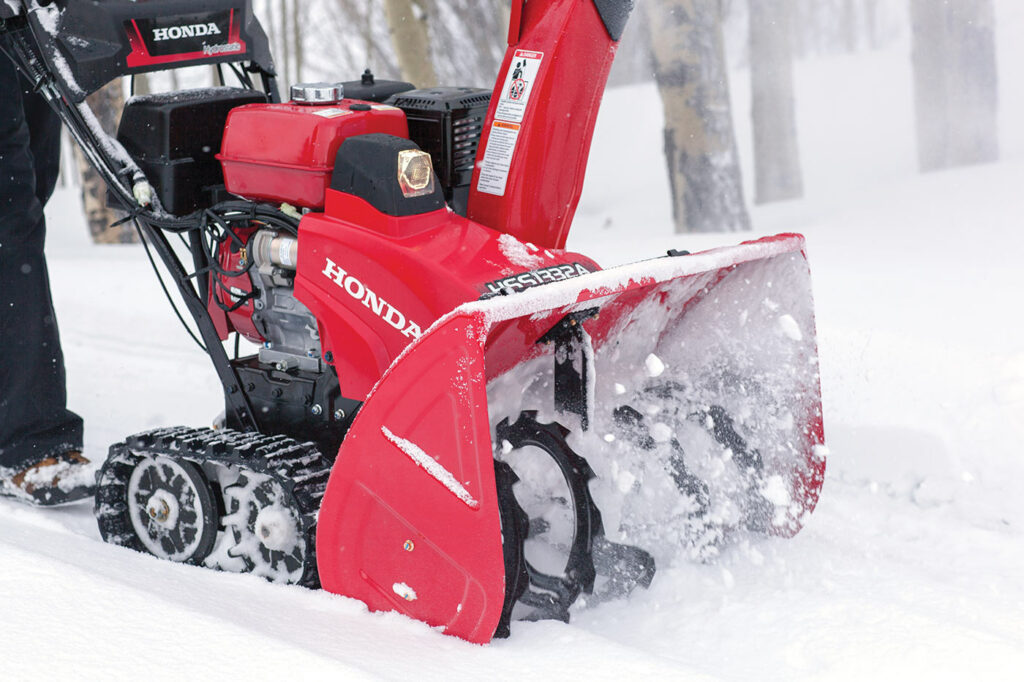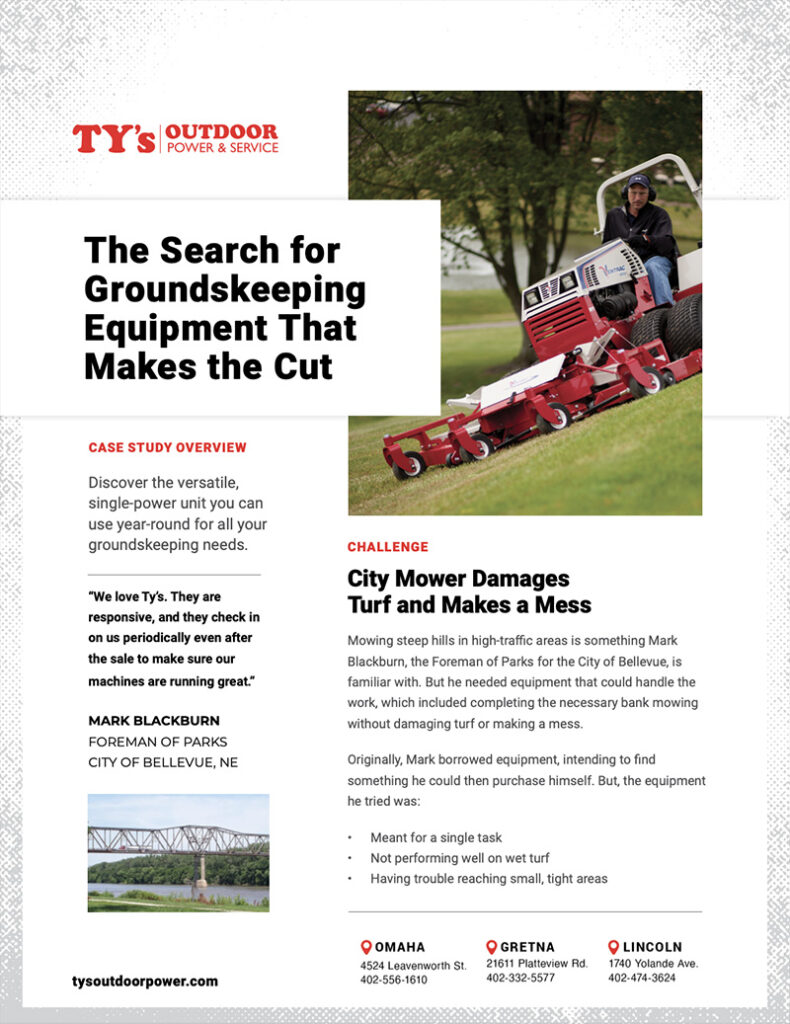Have you had your snowblower so long that you’re starting to look up snowblower troubleshooting videos on YouTube? Or maybe after a recent snow, you went to fire up your snowblower to clear your driveway and your snowblower wouldn’t start? Does your back hurt just thinking about shoveling snow? These are probably good signs that it’s time to finally buy a new snowblower. But once you’ve decided to buy, how do you know which one you need? There are plenty of models on the market today that are good for all different types of jobs. Today, we’ll give you the information you need to make an informed decision on what type of snowblower you should get next.
Different types of snowblowers
Once you’ve decided to look for a new snowblower, it’s time to do a deep dive on the different types of snowblowers that are out there. There are two main types of snowblowers: single-stage and two-stage. They can be powered by a gasoline engine, a battery, or an electric motor plugged into an extension cord. Of course, each one has its advantages and drawbacks; it’s all about knowing what you need and what level of maintenance you’re willing to commit to in the long-term, as not all snowblowers are created equal.
Single-stage snowblowers
A single-stage snowblower uses a high-speed auger to grab the snow in one single motion and propel it out the chute. Most single-stage snowblowers have rubber or plastic rotor blades that touch the ground when operating them. This method will clear snow down to the pavement really well; however, it would be a poor choice for a gravel driveway, as this could lead to projecting gravel out of the chute. These units are propelled forward by using the auger rubbing on the ground to pull the machine forward. This type of snowblower can resist clogging when moving heavy, wet snow because there is only a single mechanism touching the snow. Single-stage snowblowers are usually the lightest units because of their construction and design. This makes them very maneuverable, but most do not self-propel unless the auger is touching the ground. There are different methods of chute control. Some use a manual control where you reach over the handlebar to adjust the chute direction, and others have a chute control that is operated from behind the machine. One maintenance task on a single-stage snowblower is to replace the rotor blades and scraper bar when they wear out, since they’re always rubbing on the ground. Pay attention to how that new snowblower is constructed for future replacement of these worn parts. They come in clearing widths ranging from 16 to 24 inches. Single-stage snowblowers are generally simpler machines and easier to operate than two-stage units.
Two-stage snowblowers
A two-stage snowblower uses a low-speed auger to collect the snow and gather it into a high-speed impeller that discharges the snow out the chute. The auger does not touch the ground, so these snowblowers have a scraper bar that is adjusted just off the ground by skids mounted to the side of the snowblower. While it doesn’t clean down to the pavement, the thin layer left can easily melt in the sun. There is less wear to the auger because it’s not touching the ground. A two-stage snowblower can usually be set to leave enough snow on the ground for use on a gravel driveway without throwing gravel. These units have a drive system to drive the wheels in both forward and reverse by selecting the speed and direction on the control panel. Pay attention to how the snowblower engages for both drive wheels; some have a manual pin for two-wheel drive, some have permanent two-wheel drive, and others have a disengagement lever to temporarily not drive one wheel. Having the disengagement levers makes turning a snowblower much easier when you get to the end of a row. Some models even have a function that helps with turning at the end of a row. If you have a steep driveway or areas of poor traction, consider a unit that uses tracks to propel it instead of wheels. Two-stage snowblowers are generally larger than their single-stage counterparts and usually have larger engines. This gives them the ability to move larger quantities of snow and, depending on the snow composition, throw the snow further. Some of the wet, slushy snows tend to clog more easily in a two-stage unit (meaning you’d need to use the provided clean-out tool to clear the chute). A two-stage snowblower can use its extra weight and construction to power through the snow at the end of your driveway left by the street snowplow. Most two-stage units have chute controls that are operated from behind the machine, and they generally come in clearing widths from 20 to 36 inches. Two-stage snowblowers are generally a heavy-duty solution to moving a lot of snow.
Combination models
There are some models of snowblower that combine some features of a single-stage unit with features of a two-stage unit. One is a single-stage unit (high-speed auger) in a metal-frame snowblower that is self-propelled. Another unit puts rubber edges on the auger of a two-stage design. This allows them to clean to the pavement and use that for propelling the snowblower forward. A three-stage model adds another auger to the front of a two-stage unit that helps pull the snow into the impeller wheel. Or maybe a broom is right for you. They take the powerhead from a two-stage model, remove the snowblower part, and install a rotary broom in its place. This creates a powerful machine that can clean down to the pavement without scratching it.
Gasoline, battery, or corded
Once you’ve narrowed down which design of snowblower you’re looking for, the next decision is how the snowblower will be powered. Most snowblowers are powered by a gasoline engine, meaning they have a lot of power to get the job done. A gasoline engine gives you the freedom of using the unit until running out of fuel, adding fuel, and getting back to work. With proper maintenance and storage, a gasoline engine can give great service that is easy to start. Electronic fuel injection (EFI) is a great feature found on some high-end snowblowers. EFI is a little more forgiving on fuel that may have stored a bit too long and provides better starting as it can compensate for a cold start. Battery-powered units are another option to consider, and there are some neat benefits to using battery for your power source. Battery units just turn on and are ready to use — much easier to repeat starting procedure than a gasoline engine. Battery units are also quieter than their gasoline counterparts. There is less maintenance for a battery, but they must be stored at the right temperature and correct charge level. Unless you have a spare battery, you’ll have to wait for it to charge when it runs out of juice. The most important part of choosing a battery-powered tool is to check the specifications. Compare how much area it will clear on a charge to how much area you need to clear with a snowblower. This will determine if one battery (or set of batteries) is enough for you. The last power source is an extension cord. There are smaller units that look more like a shovel that are powered by plugging them into an outlet. These units are lightweight and can work well for clearing steps or a raised deck that would be difficult to get a traditional snowblower onto. There is not a lot of maintenance to perform on this power source. Not all combinations are available, so check with your local dealer to see the selection and availability of your preferred combination of snowblower design and power choice.
Consider how much snow falls in an average storm and how often storms come through your area. Some people like the maneuverability of a single-stage and start clearing the snow before a large storm is done so it’s not too much for the snowblower to handle. Other people want the capabilities and features that only a two-stage snowblower can offer.
Notable snowblower accessories
Once you have a good idea of which snowblower you’ll be buying — even if it’s more than one type — there are some good accessories available that are worth considering. These accessories are designed to make the snowblowing process as easy and safe as possible.
Snowblower cabs
A snowblower cab is essentially a mini tent for your snowblower, designed to help with the cold by blocking some of the wind and keeping some of the snow off you while working.
Clean-out tools
As its name implies, a clean-out tool is designed to help you get rid of snow buildup and/or a blockage in the discharge chute. NEVER USE YOUR HAND OR FOOT TO CLEAR A BLOCKAGE. Always double-check before you buy to ensure your clean-out tool works for your snowblower.
Snowblower tire chains
Older snowblowers can benefit from tire chains when there is not much traction from worn or non-aggressive tire designs of the past. Newer units have aggressive tire designs for the wheels, and some offer tracks to combat challenging environmental traction conditions. But just like with a clean-out tool, you’ll want to do your research on which type of snowblower chains work best for your model and your objectives. There are several types of snowblower chains:
- 2-Link Twist Ladder Pattern
- 4-Link Twist Ladder Pattern
- H-Pattern Twist Link
- H-Pattern V-Bar Twist Link
- Snow Hog 2-Link Twist Link Ladder Pattern
Things to remember when using a snowblower
Because a snowblower is a device that has a lot of moving mechanical parts, it’s important to remember that safety is priority #1 when using a snowblower. Accidents can always happen, so you want to minimize the risk of injury as much as possible. Below are some tips to keep you safe and efficient while blowing snow:
Don’t wear loose clothes
Loose clothes can feel great when you’re trying to stay cool or feel less constricted, but when you’re dealing with a snowblower, you want to avoid any type of fabric on your body that can potentially get caught and lead to injury.
Wear the right shoes
Tires aren’t the only thing requiring an extra layer of help. Shoes or boots with good grip can go a long way toward getting around in the snow and preventing slips and falls.
Pay attention
More than anything else, it’s really important to pay attention. Keeping your eyes on the work you’re doing and avoiding distractions will reduce the risk of accidents happening by tenfold. The importance of staying focused applies to snowblowers and any other type of machinery!
Don’t let the snowblower clog
A clogged snowblower won’t get you far, and a clog can also cause your snowblower to malfunction. Use your clean-out tool properly and often to prevent your blower from clogging. Keeping your blower in good condition will help keep it running for years to come.
Pace yourself
When it comes to snow, no matter how you’re getting rid of it, you should always pace yourself. Cold weather can trick you into thinking you’re not exerting high levels of energy because you’re not sweating as much. Therefore, it’s even more important to make sure you’re going at a reasonable pace, not just so you can get the job done more efficiently, but also to keep you safe and healthy.
There’s no project too big or too small for Ty’s Outdoor Power. For years, we’ve taken pride in being there for our customers when they need things fixed, from the smallest household repairs like scraping under the decks to changing oil and air filters. We want to help you get your project finished while also making your stuff shine like it once did. When you’re ready to buy a new (or new to you) snowblower, give us a call and we’ll help you find just the right fit.


